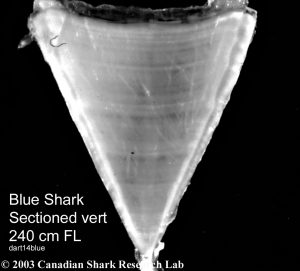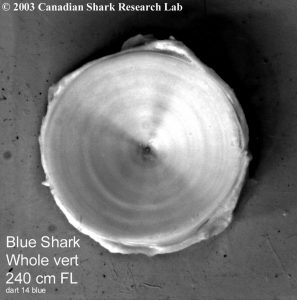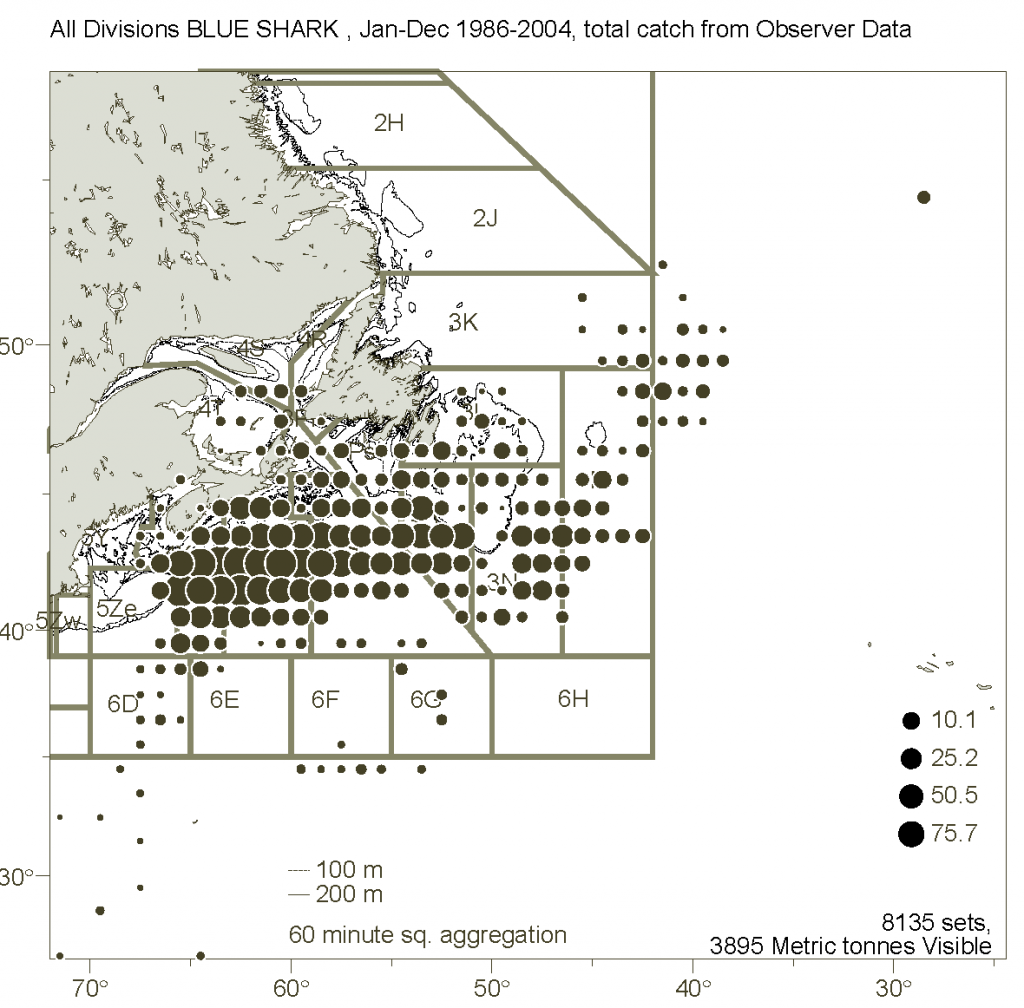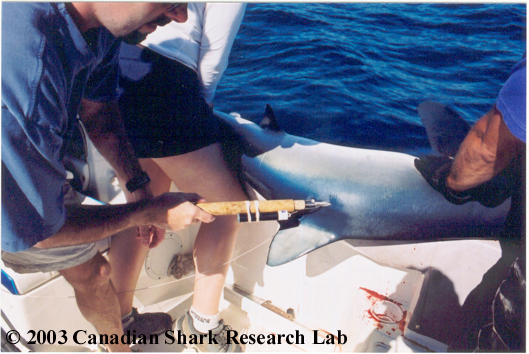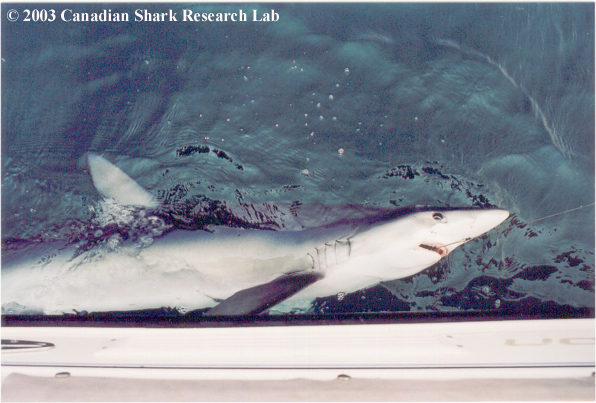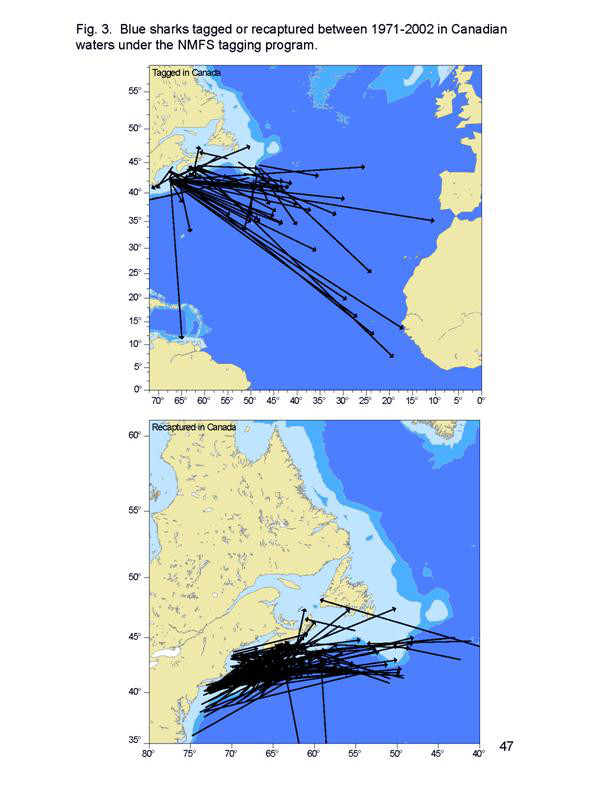Blue Shark
Prionace glauca
Despite their abundance in world oceans, the blue shark (Prionace glauca) has received relatively little attention in past years. Until recently, nothing was known of its population health in Canadian waters, yet it is frequently caught by both commercial and recreational fishers. Our research was designed to improve our understanding of blue sharks in Canada by developing a detailed overview of blue shark status in Canadian waters. We are also working cooperatively with scientific agencies from other North Atlantic countries to produce a first North Atlantic-wide stock assessment for blue shark. To do this, we must first determine the lifespan and growth rate of blue sharks, as well as their size and age at sexual maturity. A second goal has been to determine the mortality rate associated with various fisheries, both intended and unintended. This would include mortality due to shark fishing derbies and sport fishing. Finally, all of this information was to be integrated into a single view of population health.
1) Determination of age and growth rate
Numerous blue shark ve
rtebrae have been sectioned in the past two years, revealing growth bands which are believed to form yearly. The recent effort has been to determine the best method for revealing these growth bands. Our research has shown that whole vertebrae, enhanced with image analysis methods, provide the same age estimate as the more time-consuming vertebral section method. This work has now been published (MacNeil and Campana 2003).
The photos below show an example of a whole and sectioned blue shark vertebra, enhanced with the image analysis system. Yearly growth bands appear as paired light and dark bands.
2) Distribution in Canadian waters
Blue sharks are common in Canadian waters, particularly in the summer and fall months. In the map below (adapted from Campana et al. 2004), the distribution of some of the blue sharks caught by commercial fishermen is shown. Note that each symbol corresponds to many sharks, with the size of the symbol proportional to the total weight of the sharks as shown in the legend.
3) Impact of shark derbies on the health of the blue shark population
Shark fishing derbies are held in waters off Nova Scotia during the months of July, August and September. These are commercial or community-sponsored events, and are not sponsored by DFO or the Shark Research Lab. While there are social and economic benefits to a healthy recreational shark fishery, it is important that the derbies not unduly impact the health of the population. In other words, the populations of each of the shark species must be conserved at safe levels.
Each and every shark caught at a shark derby has been examined and measured by members of the Shark Research Lab. An analysis has now been completed to determine the impact of shark derbies on the blue shark population (Campana et al. 2004), and on the overall health of the blue shark population (Campana et al. 2006). The analysis looked at year to year trends in the catch rates, size composition, maturity at size and mortality rates, both in the derby catches and in commercial bycatches. The results indicated that blue shark abundance has declined, and mortality has increased, in the past decade. However, derby catches were a minor component of overall mortality (about 2%) compared to accidental bycatches by tuna and swordfish fishers. Blue sharks are highly migratory - migrations across the North Atlantic are common - and most of the blue shark mortality takes place outside of Canadian waters. Therefore, international action will be required to reduce mortality rates. In the interim, the Shark Research Lab will continue to monitor the health of the population.
4) Diet
A quantitative analysis examining the stomach contents of 706 blue sharks caught in recreational shark fishing tournaments (between 1999 and 2001) was conducted to determine dietary differences based on sex, maturity and tournament location.
Our results indicate that blue sharks off Nova Scotia feed primarily on pelagic fish (mackerel and herring) and groundfish (cod and lumpfish). Differences existed between the diets of immature and mature sharks of both sexes suggesting sexual segregation during feeding. As well, the frequency of pelagic fish and groundfish present in stomachs changed across sampling years. Similar to porbeagles, it was found that blue sharks consume small bits of garbage and debris floating in the water column. This work has now been published (McCord and Campana, 2003).
5) Satellite transmitters and hooking mortality
Most of the blue sharks caught in the North Atlantic are caught accidentally during commercial fishing operations for species such as swordfish and tuna. Almost all of the blue sharks are released at sea (including the 10-20% that are already dead), but scientists around the world currently assume that many of the remainder die after release. The exact proportion that die is unknown, but this number is important: if most of the released sharks survive, there is no great problem. But if most die after release, bycatch mortality may be the major cause of the observed population decline.
To determine the mortality rate of blue sharks caught and released by commercial longliners, archival satellite pop-up tags were applied to a small percentage of the sharks caught during normal commercial swordfishing operations. These computerized tags record the depth and temperature of the water every few minutes, and thus record any evidence of death (sinking to the ocean bottom or floating to the surface). At a pre-programmed date (usually 3-6 months after tagging), the tag releases from the shark, floats to the ocean surface, and then transmits all of the stored data to an orbiting satellite. The data is then sent to our lab, where we determine the location and swimming history of the shark as well as whether or not it died.
Our research indicated that overall blue shark bycatch mortality in the pelagic longline fishery was 35%, while the estimated post-release mortality for sharks that were released alive was 19%. All healthy sharks survived, while 33% of those that were badly injured or gut hooked subsequently died. Survival time models indicated that 95% of the mortality occurred within 11 d of release, indicative of death by trauma rather than starvation. The annual blue shark catch in the North Atlantic was estimated at about 84 000 t, of which 57 000 t is discarded. A preliminary estimate of 20 000 t of annual dead discards for North Atlantic blue sharks is similar to that of the reported nominal catch, and could substantially change the perception of population health if incorporated into a population-level stock assessment. This work has been published (Campana et al. 2009). A companion article compares the discard mortality rate in the Atlantic with that in the Pacific (Campana et al. 2009c).
Recreational shark fishing uses rod and reels, rather than longlines. Therefore, the post-release mortality of recreationally-caught blue sharks is likely to be different than that determined for pelagic longliners. Beginning in 2011, we have begun to deploy 20 satellite tags on injured and healthy blue sharks caught by recreational fishermen. The aim is to quantify post release mortality from recreational shark fishing.
Blue sharks being tagged with satellite tags
6) Blue shark migrations, satellite tags and overwintering grounds
Although the blue shark is known to be highly migratory, its migration pathways towards the overwintering grounds remain poorly understood. We used archival satellite pop-up tags to track 23 blue sharks over a mean period of 88 days as they departed the coastal waters of North America in the autumn. Within 1œ2 days of entering the Gulf Stream (median date of 21 Oct), all sharks initiated a striking diel vertical migration, taking them from a mean nighttime depth of 74 m to a mean depth of 412 m during the day as they appeared to pursue vertically migrating squid and fish prey. Although functionally blind at depth, calculations suggest that there would be a 2.5-fold thermoregulatory advantage to swimming and feeding in the markedly cooler deep waters, even if there was any reduced foraging success associated with the extreme depth. Since the Gulf Stream current speeds are reduced at depth, we used a detailed circulation model of the North Atlantic to examine the influence of the diving behaviour on the advection experienced by the sharks. However, there was no indication that the shark diving resulted in a significant modification of their net migratory pathway. The relative abundance of deep-diving sharks, swordfish, and sperm whales in the Gulf Stream and adjacent waters suggests that it may serve as a key winter feeding ground for large pelagic predators in the North Atlantic. This work has been published (Campana et al. 2011).
7) Population dynamics
Blue sharks appear to be one of the most common of the large shark species in Atlantic Canada. Although caught frequently by recreational fishers, they are also caught unintentionally by commercial fishers (as bycatch). An analysis tabled in the fall of 2002 estimated that the biomass of blue sharks caught as bycatch in commercial fisheries ranged between 1000-2000 mt per year. Thus the unreported catch was much greater than the landed catch. Click on the name of the following Fisheries Status Report to download it as a Word 97 document: Catch, bycatch and landings of blue shark in the Canadian Atlantic. The complete analysis is presented in Campana et al. (2002). Updated bycatch estimates were provided in 2011 (Campana et al. 2011). These results provide background context for the interpretation of the impact of the derby and recreational catches on the overall population.
Until now, nothing was known of the population health of blue shark in either Canadian or North Atlantic waters. By integrating our research results on bycatches, shark derbies, age determinations and mortality estimates, we prepared a first analysis of blue shark status in Canada (Campana et al. 2006). The analysis looked at year to year trends in the catch rates, size composition, maturity at size and mortality rates, both in the derby catches and in commercial bycatches. The results indicated that blue shark abundance had declined slightly, and mortality had increased, in the past decade. More recent analyses do not show evidence of a decline (Fowler and Campana 2009). However, blue sharks are highly migratory, and it appears that there is a single population in the North Atlantic that is shared by multiple countries. Therefore, international action by ICCAT will be required to regulate blue shark population mortality.
8) Conventional tagging studies
The Shark Research Laboratory cooperates with the U.S. shark tagging program in Narragansett, Rhode Island.. Under this program, cooperating fishers (primarily sports fishers) in Canada insert darted tags into blue sharks caught in our waters, some of which are later recaptured. In the figure below from Campana et al. (2004), some of these tag-recapture results are shown. Many of the blue sharks tagged in Canadian waters are later recaptured in the mid-Atlantic, or even as far away as Africa. In contrast, many of the blue sharks caught in our waters with tags in them were initially tagged in U.S. waters. Taken as a whole, these results demonstrate that blue sharks are highly migratory, and probably do not remain in Canadian waters for more than one season at a time.
